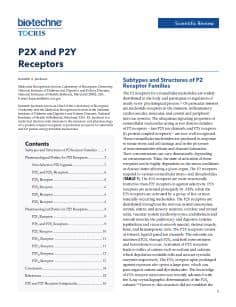Adenosine Receptors
Adenosine is an endogenous nucleoside that is present in all body fluids where it predominantly exhibits a cytoprotective function. Four adenosine receptors (P1 purinergic receptors) have been cloned from several mammalian species and have been classified as A1, A2A, A2B and A3.
Adenosine Receptor Target Files
Related Targets
Adenosine receptors are all G-protein-coupled and exhibit distinct pharmacological profiles. Due to their widespread distribution on nearly every cell type, adenosine receptors are an attractive target for pharmacological intervention.
Literature for Adenosine Receptors
Tocris offers the following scientific literature for Adenosine Receptors to showcase our products. We invite you to request* your copy today!
*Please note that Tocris will only send literature to established scientific business / institute addresses.
Adenosine Receptor Data
| Receptor Subtype | A1 | A2A | A2B | A3 |
|---|---|---|---|---|
| Transduction Mechanism | ↓Adenylyl Cyclase (Gi/o) and ↑ PLC | ↑Adenylyl Cyclase (Gs) | ↑Adenylyl Cyclase (Gs) and ↑ PLC (Gq) | ↓Adenylyl Cyclase (Gi/o) and ↑ PLC |
| Primary Distribution | Brain (cortex, cerebellum, hippocampus), spinal cord, eye, adrenal gland, atria | Spleen, thymus, leukocytes, platelets, striatopallidal GABAergic neurons, olfactory bulb | Cecum, colon, bladder | Testis, mast cells |
| Tissue Function | Antinociception, hypothermia, sedation, sleep, inhibition of lipolysis, cardio- and neuroprotection | Reflex tachycardia, vasodilation, inhibition of platelet aggregation, sleep, protection against ischemia | Relaxation of vascular and intestinal smooth muscle, cytokine production, inhibition of cell proliferation | Mast cell degranulation, coronary vasodilation and protection from reperfusion |
| Key Compounds | Ki Values (nM) | ||||
|---|---|---|---|---|---|
| Agonists |
CGS 21680 (1063) 2-Chloro-N6-cyclopentyladenosine (1705) 2-Cl-IB-MECA (1104) N6-Cyclopentyladenosine (1702) HEMADO (1579) IB-MECA (1066) 2'-MeCCPA (2281) NECA (1691) SDZ WAG 994 (2465) |
290 0.8 820 (rat) 2.3 327 3.7 3.3 14 23 |
27 2300 470 (rat) 790 1230 2500 9580 20 - |
88800* 18800* - 18600* 100000* 11000* 37600 2400* 25000 |
67 42 0.33 (rat) 43 1.1 1.2 1150 6.2 - |
| Antagonists |
CGS 15943 (1699) DPCPX (0439) MRS 1220 (1217) MRS 1334 (1385) MRS 1706 (1584) MRS 1754 (2752) MRS 3777 (2403) PSB 36 (2019) SCH 442416 (2463) VUF 5574 (1359) ZM 241385 (1036) 8-(3-Chlorostyryl)caffeine (3306) PSB 1115 (2009) PSB 603 (3198) |
3.5 3.9 305 (rat) > 100000 (rat) 157 403 > 10000 0.12 (rat) 1111 ~ 10000 (rat) 540 28200 > 10000 > 10000 |
4.2 130 52 (rat) > 100000 (rat) 112 503 > 10000 552 (rat) 0.048 > 10000 (rat) 1.4 54 24000 > 10000 |
16 50 - - 1.39 1.97 > 10000 187 > 10000 - 31 - 53.4 0.568 |
51 4000 0.7 5.69 230 570 47 2300 > 10000 4 270 - > 10000 > 10000 |
* EC50 values
References
Klotz et al (2000) Naunyn-Schmied.Arch.Pharmacol. 362 382.Kim et al (1994) J.Med.Chem. 37 3614. van Muijlwijk-Koezen et al (2000) J.Med.Chem. 43 2227. Kim et al (2000) J.Med.Chem. 43 1165. Volpini et al (2002) J.Med.Chem. 45 3271. Li et al (1998) J.Med.Chem. 41 3186. Cappellacci et al (2005) J.Med.Chem. 48 1550. Osama et al (2004) J.Pharmacol.Exp.Ther. 308 358. Toddle et al (2000) J.Med.Chem. 43 4359. Jacobson and Gao (2000) Nat.Rev.Drug Discov. 5 247.
